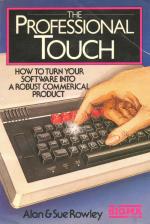The Professional Touch is an appropriately double-edged title for a new book by Alan and Sue Rowley, published by Sigma Press, priced £7.95. The presentation is highly professional and the content will indeed help you add a professional touch to your programs, be they for personal use or destined for a wider audience.
Above all, the sort of detailed and clever error trapping, screen design and input routines that are described and demonstrated here, will make your programs much more desirable and friendly to use. The newcomer to BBC BASIC on BBC or Electron couldn't ask for a better start than trying out a few of the Rowleys' ideas, which are fully explained and backed up with neat, efficient listings for you to have a go at.
Any software user will be interested in the treatment of command and menu driven programs, methods of restricting keyboard input to what the program requires, input editing and validation and screen handling.
Screen design and text handling, output to screen and printer, character and colour manipulation and numerical formatting are all given the careful attention they demand (programmers take note!).
Anyone who has used a serious piece of software demanding considerable amounts of data input/output will appreciate the above but even more so the section on error handling. To outguess the user, to cover all the possibilities and to tidy up after errors need not be hard work for the programmer and the end user will be so appreciative.
Programs for business and finance deals with the special attention required by data formats, data encryption, passwords and accuracy of calculation.
Moving on from BASIC, the authors apply the same sensible approach to dealing with various Acorn filing systems. It's nice to see a book which has taken the trouble to be up to date with a decent (though not comprehensive) look at the relationships between DFS and ADFS and DFS and CP/M on the Z80 second processor.
A chapter on compatibility brings in BASIC 1 and 2, second processors and B+. Three chapters on a lighter note conclude, on concealment of program listings and disc catalogues, on documentation - remember there is always one last bug! - and a program for printing function key strips. There's a list of useful addresses and an index.
The Professional Touch is certainly a good read. It packages some very useful information but is most enlightening perhaps for the BASIC programmer wanting to present a program before joe public and wanting to make sure that joe is allowed to derive maximum benefit, without confusion or crashes!


 1st March 1986
1st March 1986
